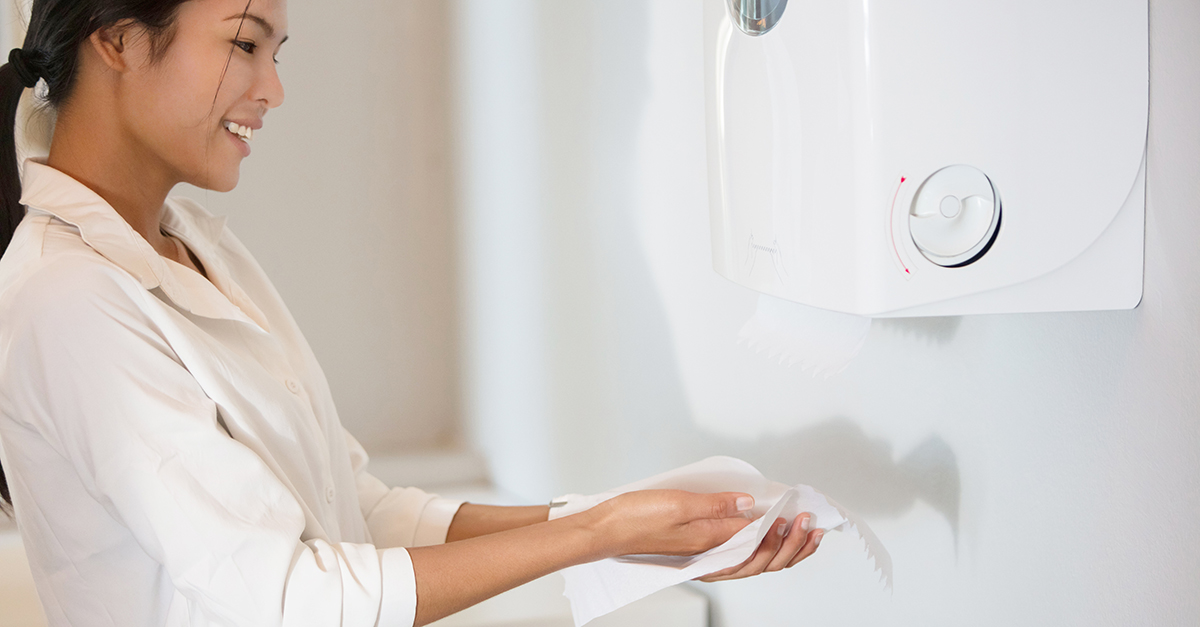Washing our hands with soap and water is one of those tasks that we learn early in life. We learn to wash our hands before meals, after using the restroom, before holding a baby, and after coughing, sneezing, and blowing our nose. Many of us are even taught to wash our hands for a full 20 seconds, something that was strongly reinforced during the COVID-19 pandemic. Today, we would be hard pressed to find someone who hasn’t seen a public health campaign, watched a commercial, or heard a catchy jingle about the importance of handwashing.
While it’s great that handwashing is getting the love and attention it deserves, it raises the question of why hand drying isn’t. After all, the U.S. Centers for Disease Control & Prevention (CDC), the Cleveland Clinic, the Mayo Clinic, and Harvard Medical School state the importance of hand drying after handwashing. Yet, no commercials or catchy jingles encourage us to do it.
Strong data supports hand drying. In a 2023 Consumer Reports article, a physician from Mount Sinai Doctors Ansonia in New York City shared that damp hands can spread 1,000 times more bacteria than dry hands. CDC statistics show that in the U.S., more than 2.8 million antimicrobial-resistant infections occur each year resulting in 35,000 deaths. And according to researchers at the University of Westminster in London, when we thoroughly dry our hands with a paper towel after washing them, we decrease the bacteria on our hands by up to 76.9%.
Make hand drying a habit
Despite the variety of data in support of thorough hand drying, are consumers aware of it? Are they heeding its advice?
A recent GP Pro survey on consumer handwashing and hand drying behavior in public restrooms found that just 55% of consumers believe the most effective way to clean their hands is to wash with soap and water and dry thoroughly, leaving nearly half who don’t consider the efficacy of hand drying. Further, when asked how clean they consider their hands to be when they’re unable to dry them through traditional means, more than one-third of consumers said very clean and more than two-thirds said clean enough.
Perhaps we need to change the vernacular. When we encourage our employees and facility inhabitants to wash their hands regularly, what we really mean is for them to wash and dry their
hands. Washing is stated, drying is implied. By not stating it aloud are we doing a disservice to the importance of hand drying? Do we need to coin a new word or phrase that encompasses both
handwashing and drying, like washadry (wash and dry) or cleanwel (cleanse and towel)? Maybe we need to rename those public restroom stickers to say, “Handwashing and Drying Steps” or “Steps for Clean Hands.”
If we intrinsically know that we should dry our hands after washing them, why aren’t we? Perhaps we need to build up our habit-making muscles. According to a 2021 article in the Harvard
Business Review, roughly half of our daily actions are driven by repetition, which makes developing positive habits so important to our wellbeing. The article lists several steps for developing a habit, such as setting intentions and creating a schedule. It also suggests a dedicated commitment will drive incremental progress.
Provide options for drying
Although nearly half of the survey respondents don’t believe that drying hands is essential to having clean hands, 67% said not having what they need to wash and dry their hands in a public
restroom negatively impacts their perception of the facility. This finding has relevance for facility managers and custodians. Regardless of whether consumers know they should dry their hands,
regardless of whether we help make hand drying a habit, and regardless of whether consumers actually want to dry their hands, if no way exists for them to do so in a public restroom, the facility’s
perception takes a hit.
Fortunately, technology solutions are readily available to help ensure consumers have a way to thoroughly dry their hands when away from home. We’ve all been in restrooms where the paper towel dispenser is broken or empty, forcing us to use toilet paper or our clothing to dry them, or simply walk out with wet hands. One solution to this conundrum is automated, high-capacity
paper towel dispensing systems that automatically switch to a new roll when the first roll runs out. Some of these dispensers include technology to help reduce paper towel jams.
Smart technology is another solution for keeping restrooms stocked with paper products and other supplies. Internet of things (IoT)- connected dispensers send alerts to custodians when the dispensers are running low on paper towels, ensuring restrooms remain functional.
These solutions help improve the likelihood that consumers will always have access to paper towels, which not only improves hand cleanliness and hygiene but preserves a facility’s perception.
Look for a helping hand
At the end of the day, we each bear responsibility for the hand hygiene information sources we trust and for our personal away-from-home hand hygiene behaviors and habits. But facility
managers bear the responsibility of partnering with manufacturers who can provide a helping hand in ensuring the most effective hand hygiene habits.



